CBSE Sample Papers for Class 12 Biology Set-5
Class 12thCBSE Sample Papers for Class 12 Biology Set-5
CBSE Sample Papers for Class 12 Biology Set 5 with Solutions
Time : 3 Hours
Maximum Marks : 70
General Instructions:
- All questions are compulsory.
- The question paper has five sections and 33 questions. All questions are compulsory.
- Section-A has 16 questions of 1 mark each; Section-B has 5 questions of 2 marks each; Section-C has 7 questions of 3 marks each; Section-D has 2 case-based questions of 4 marks each; and Section-E has 3 questions of 5 marks each.
- There is no overall choice. However, internal choices have been provided
in some questions.
A student has to attempt only one of the alternatives in such questions. - Wherever necessary, neat and properly labelled diagrams should be drawn.
Section A
Question 1.
During the production of yogurt and cheese, the mixture
undergoes a pH change. This change in pH is brought about by
(a) conversion
of milk proteins to solid forms
(b) conversion of lactose to lactic acid
(c) release of CO2
(d) ethanol production
Answer:
(b) The
change in pH in the production of yogurt and cheese occurs due to the action of
bacteria called Lactobacillus. These bacteria convert lactose present in milk to
lactic acid, which being an acid lowers the pH of reaction mixture.
Question 2.
During transcription, holoenzyme RNA polymerase binds to DNA
sequence which form a saddle-like structure at this point. The sequence to which
the enzyme binds is
(a) TATA box
(b) GCT box
(c) CAAT box
(d) AAAT
box
Answer:
(a) TATA box is the 7 bp long DNA sequence present in
eukaryotic promoter region. During the
transcription process, the RNA
polymerase binds to this TATA box which results in DNA assuming a
saddle-like
structure.
Question 3.
Population interactions
| Organisms A | Organisms B | Names of interaction |
| + | + | Mutualism |
| – | – | A |
| + | – | Predation |
| + | – | B |
| + | 0 | Commensalism |
| – | 0 | C |
‘+’ sign for beneficial interaction.
‘-‘ sign for harmful (detrimental)
interaction.
‘0’ sign for neutral interaction.
Find out what could be A, B
and C?
(a) A-Amensalism, 5-Parasitism, C-Competition
(b) A-Competition,
B-Parasitism, C-Amensalism
(c) A-Competition, B-Amensalism, C-Parasitism
(d) A-Amensalism, B-Competition, C-Competition
Answer:
(b) A –
Competition
B – Parasitism
C – Amensalism
Question 4.
A pair of an animal and a plant which have been labelled as
endangered (from India) in the Red Data Book is
(a) Banyan and Black buck
(b) Tamarind and Rhesus monkey
(c) Bentinckia nicobarica and Red panda
(d)
Azadirachta indica and Deer
Answer:
(c) A taxon is endangered when it is
facing a very high risk of extinction In the wild, in near future.
In India,
Bentinckia nicobarica, a species of flowering plant endemic to great Nicobar and
Red panda has entered the endangered list.
Question 5.
The pyramid of biomass will be inverted for a
(a) grassland
ecosystem
(b) smaller food chain
(c) ecosystem where a big fish prey on
large number of smaller organisms
(d) ecosystem where a single tree feeds a
larger population
Answer:
(c) The pyramid of biomass will be inverted in
shape for an aquatic / marine / pond ecosystem. In such ecosystem, a single big
size organism like fish preys upon large number of phytoplanktons (i.e. smaller
organisms).
Question 6.
An adaptive feature which cannot be associated with xerophytic
plant is
(a) extensive, long tap roots system
(b) sunken stomata
(c)
succulent organs
(d) pneumatophores in horizontal roots
Answer:
(d)
Pneumatophores are negatively geotropic vertical roots present in plants,
adapted to marshy areas like the mangroves.
Rest other options are correctly
associated with xerophytic plants which are found in regions like deserts.
Question 7.
Ecosystem need a constant supply of energy
(a) to
counteract increasing disorderliness
(b) to counteract decreasing
disorderliness
(c) to synthesis molecules
(d) Both (a) and (c)
Answer:
(d) Both (a) and (c)
Question 8.
The table below depicts the level of oxygen, numbers of
aquatic plants and fishes and the level of organic matter in the rivers P, Q, R
and S flowing across four towns. The water from which river is most polluted and
requires urgent treatment?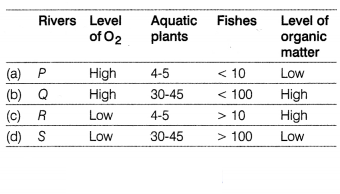
Answer:
(c) The river ‘R’ is the most polluted and need urgent treatment
because here, the level of organic matter is high due to which alga or other
organism may have grow on it. This leads to reduce level of O2 in
water. Due to which the aquatic plants and fishes are also affected which result
in reduction in their population.
Question 9.
Genes inserted in transgenic animals and their effects are
given below. Which of them is correct?
| Transgenic animals | Gene inserted | Effects / benefits | |
| (a) | Sheep | Anti-haemophiiic factor IX | High yield of milk |
| (b) | Goat | TPA gene | Easy extraction of TPA rich milk, treat coronary thrombosis |
| (c) | Cows | γ-1-antitrypsin | Produce milk with AAT-1 treat
emphysema |
| (d) | Pigs | hGH (human Growth Hormone) gene | Leaner pork |
Answer:
(b) In transgenic goat, the blood clot dissolving gene called TPA
was inserted. It produced rich milk with TPA which could be easily recovered at
lower costs and provide effective treatment to patients with coronary
thrombosis.
Question 10.
A couple trying to have a child, recently found out, that the
male partner has no sperm in his reproductive tract. Identify the ART which
could help this couple to achieve conception.
| Method of ART | Specifics | |
| (a) | Testicular sperm extraction | Collection of sperm from testis |
| (b) | Intra-cytoplasmic sperm injection | Directly injecting sperm into cytoplasm of ovule |
| (c) | Artificial donor insemination | Donated sperm is inseminated in woman’s uterus |
| (d) | In vitro fertilisation | Fertilising sperm and ovule outside the body |
Answer:
(c) For this couple where male partner has no sperm in his
reproductive tract, artificial donor insemination would be most appropriate. In
this process, sperms from a male donor are extracted and used to inseminate the
female.
Question 11.
Plasmodium falciparum is an
(a) ectoparasite
(b)
endoparasite
(c) obligate parasite
(d) facultative parasite
Answer:
(b) Plasmodium falciparum is an endoparasite, since it lives inside the organs
(i.e. liver) of its host.
Question 12.
The figure below depicts the hormonal control of male
reproductive system.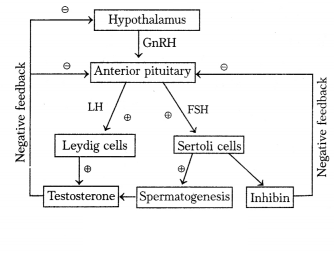
Due to a specific mutation in anterior pituitary, the secretion of GnRH gets
reduced. Which of the following is the correct observation for this
condition?
| Observation | Effect | |
| (a) | Low levels of LH and FSH | Testosterone deficiency |
| (b) | Increased levels of LH and FSH | Enlarged testis |
| (c) | Low levels of LH and FSH | No oogenesis affecting the gamete production |
| (d) | Increased levels of gonadotropins | Sterile male |
Answer:
(a) In males absence/reduce production of GnRH would affect the
secretion of LH (Luteinizing Hormone) and FSH (Follicle Stimulating Hormone). As
a result, there will a deficiency of testosterone, the testes fails to grow and
no spermatogenesis will occur. Thus, affecting the production of sperm.
Question Nos. 13 to 16 consist of two statements, Assertion (A) and Reason
(R). Answer these questions selecting the appropriate option given below.
(a)
Both Assertion and Reason are true ‘ and Reason is the correct explanation
of
Assertion
(b) Both Assertion and Reason are true, but Reason is not the
correct explanation of Assertion
(c) Assertion is true, but Reason is
false
(d) Assertion is false, but Reason is true
Question 13.
Assertion (A) : Mango is a false fruit.
Reason (R) :
Thalamus participates in false fruits formation.
Answer:
(d) Assertion is
false, but Reason is true.
Mango is a true fruit, as it develops only from
the ovary. In false fruits, thalamus also participates.
Question 14.
Assertion (A) : Polycistronic mRNA is capable of forming a
number of different polypeptide chains.
Reason (R) : Polycistronic mRNA has
terminator codons.
Answer:
(b) Both Assertion and Reason are true, but
Reason is not the correct explanation of Assertion. Polycistronic mRNA is
commonly found in prokaryotes, contains two or more coding regions which can
specify a number of different polypeptides chains. Both the polycistronic and
monocistronic mRNAs have a 5’ leader sequence which contains an initiation and
termination codon and a non-translated 3’tailor sequence.
Question 15.
Assertion (A) : GM plants have undergone a genome
modification for developing various resistances.
Reason (R) : The plasmid
vectors used for plant cell transformations are based on Ti-plasmids.
Answer:
(b) Both Assertion and Reason are true, but Reason is not the correct
explanation of Assertion.
In RDT, various GM plants have been undergone modification in their genomes to provide resistances to them. Since, plants do not have endogenous plasmids, Agrobacterium, a pathogen of several dicot plants is used to transform normal plant cells in RDT. It can deliver or piece of its DNA called T-DNA which can be used to deliver the gene of interest in plant cells.
Question 16.
Assertion (A) Keystone species are not relevant to
biodiversity conservation.
Reason (R) Keystone species have a significant
impact on community structure and characteristics.
Answer:
(d) Assertion
is false, but Reason is true. Assertion can be corrected as
Keystone species
are the important and relevant component of ecosystem balance and
biodiversity
conservation. These are species which have a significant and
disproportionately large influence on community structure and
characteristics.
Section B
Question 17.
Cloning sites are required in a vector to facilitate the
action of restriction enzymes during genetic engineering process. What will
happen if many recognition sites are present within the vector?
Answer:
Cloning sites are required to link foreign DNA with the vector DNA. These sites
are also called recognition sites as these are recognised by the restriction
enzymes.
An ideal vector should have single or very few cloning sites. If more than one recognition sites are present within the vector, it will generate several fragments which will lead to more complications in gene cloning.
Question 18.
In the figure below, different methods of contraceptions are
shown. Study them and answer the questions that follows.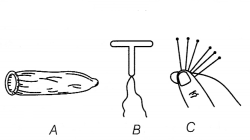
(i) Name these methods of contraceptive measures. Also
mention which one of these is better suited for prevention against an STD.
(ii) How are these methods better than the natural methods of contraception?
Answer:
(i) A – Condom, B – Copper-T C – Implants
Condoms are better for
prevention against STDs. They are 98% effective against STD transmission.
(ii) In these methods depicted in question there is a protection against unwanted pregnancy which is not assured with natural methods of contraception like lactational amenorrhea where a chance meeting of gametes can occur.
Question 19.
The following diagram, exhibits the feeding relationship
between different animals in a forest.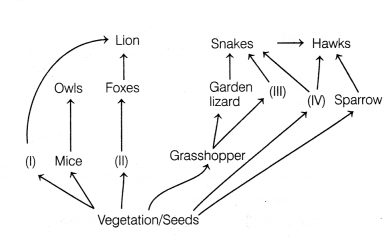
Interpret the given diagram and identify the animals that may be present at
stages I-IV.
Also explain, why is the first trophic level always occupied by
a plant.
Answer:
This diagram represents a food web. It is an
interconnected network of food chains that operates in an ecosystem. Organisms
at l-IV are most likely to be deer, rabbit, frog and rat, respectively.
Green plants are producers which occupy the first trophic level in all food chain (except detritus). This is because they can utilise the solar energy to form organic compounds during photosynthesis. They, making food for themselves and for other organisms also. This is the reason that every organism in a food chain depends on them either directly or indirectly.
Question 20.
The figure given below indicates the uncontrolled growth of
cells which results in tumour. These can be either benign (stay in fix spot) or
malignant (can move to other parts of the body) and can cause cancer.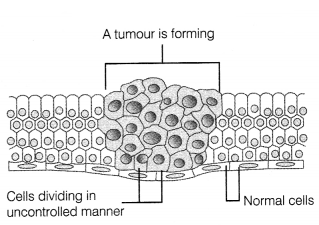
Based on the above figure answer the ‘following questions.
(i) Cancer is one
of the most dreaded disease. Explain contact inhibition with respect to the
disease.
(ii) Cancer patients often given a-interferon as a part of the
treatment. Give reason.
Answer:
(i) Contact inhibition is the property
possessed by normal cells. Due to this the growth of cells stops, when come in
contact with other cells. But in case of cancer cells, this property is inactive
or lost. As a result of it, cancer cells divide continuously to give rise to a
mass of cells called tumours.
(ii) Cancer patients often given a-interferon (biological response modifies) as a part of their treatment because it activates patients’s immune system and helps in destroying the tumour.
Question 21.
Given below are the modifications in the wings of different
organisms.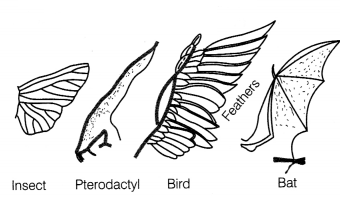
(i) What conclusion can you derive with respect to these organisms?
(ii) How
does the study of comparative morphology and anatomy helpful in evolutionary
studies.
Or
In a typical nucleus, some regions of chromatin are stained
light and other dark. Explains why is it so and what is its significance?
Answer:
(i) The wings of these organisms perform the same function, i.e.
flight, although they have different origins and different structures. These
organs are thus, identified as analogous.
(ii) It is seen that inspite of a large number of organisms unlike in
appearance they show most of the organs made on the same body plan. This
provides evidence of common ancestry.
Or
In a typical nucleus, some
regions of chromatin are stained light because of loose packing of chromatin and
some regions of chromatin are stained dark because herein the chromatin is
densely packed.
Euchromatin is transcriptionally active chromatin (lightly
stained), while heterochromatin (darkly stained) is transcriptionally
inactive.
Section C
Question 22.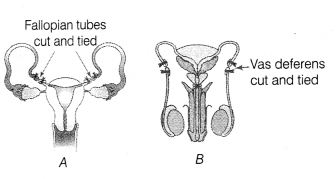
With reference to the above diagram of
(A) Tubectomy and (B) Vasectomy,
answer the following questions.
(i) Why are these methods known as the
contraception?
(ii) Why these methods are generally not recommended to young
couples?
Answer:
(i) Both vasectomy and tubectomy are the surgical methods
of contraceptives. These are called so because this method prevent the meeting
of sperm with ovum. In vasectomy a small portion from vas deferens is removed or
tied up through a small incision on the scrotum. Similarly in female a small
part of the Fallopian tube is removed or tied up with Incision in
abdomen/vagina. Due to the blockage in the accessory ducts, the gametes do not
reach their destination, i.e. urethra in male and Fallopian tube in female. So,
the surgical intervention block the gamete transport and thereby prevent
conception.
(ii) These methods are highly effective as they block i transport and fusion of gametes, but are irreversible in nature. Hence, are not suggested to young couples.
Question 23.
It is generally observed that children who had suffered from
chickenpox in their childhood may not contact the same disease in their
adulthood. Explain giving reason the basis of such as immunity in an individual.
Name this kind of immunity.
Answer:
A child who had suffered from
chickenpox in childhood may not contact disease in his/her adulthood. It is
because during the first encounter with pathogen (chickenpox) specific
antibodies (by humoral immune response) are produced to counter the attack.
During this attack, memory cells are also produced. Due to this, on subsequent exposure to the same pathogen, the immune response is more rapid and intense. That is why, second exposure to the chickenpox does not cause disease. It is known as acquired immunity of the body.
Question 24.
In nature, living organisms such as animals, plants and
microbes cannot live in isolation and therefore, interact in various ways to
form a biological community some example of these interaction include, lichens,
lion and deer, lice on human, etc.
(i) Why are herbivores considered similar
to predators in the ecological context? Explain.
(ii) Lichens represent an
intimate relationship between a fungus and photosynthetic algae or
cyanobacteria. Explain.
Answer:
(i) The herbivores feed on plants. They
are considered as predators because they transfer energy across the trophic
levels. Besides this, they also keep the population of their prey under control.
For example, when the prickly pear cactus was introduced in Australia in early
1920, they spread rapidly causing havoc. There population was controlled by
introducing cactus-feeding predator (a moth).
(ii) Mutualism is the interaction which confers benefits to both interacting species. For example, lichens represent a mutualistic relationship between a fungus and an alga (photosynthesising). In this, the fungus helps in nutrient absorption and provides protection, while the algae prepare the food.
Question 25.
The graph given below shows the usage of pesticides on Bt
crops and non-Bf crops, in four types of farm lands. Cotton bollworm were
introduced in lands where in no pesticide was used.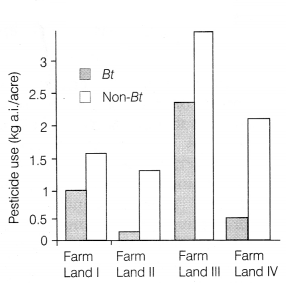
(i) Explain what effect would a Bt and non-Bt crop have on the pest?
(ii)
Which of the below four farm lands have successfully applied the concepts of
biotechnology to show better management practices and use of agrochemicals?
Answer:
(i) In Bt cotton a cry gene has been introduce from bacterium
Bacillus thuringiensis (Bt) which causes synthesis of a toxic protein. This
protein becomes active in the alkaline gut of bollworm feeding on cotton,
punching holes in the lining causing death of insect. However, a non-Bf crop
will have no effect on the cotton bollworm, thus yield of cotton will decrease
and non-Bf cotton crop will succumb to pest attack.
(ii) Farm land II because the use of pesticides is highly reduced for Bt crop. Decrease of pesticide used is also more significant for Bt crop.
Question 26.
Highlight the structure of nucleosome and its importance in
DNA packaging in eukaryotes.
Answer:
Nucleosome is a complex of negatively
charged DNA wrapped around the positively charged histone octamer (unit of 8
molecules of histone). It is made up of four types of proteins, H2A,
H2B, H3 and H4 occurring in pairs.
H1 acts as linker histone that connect one histone octamer to
another. A typical nucleosome consists of 200 base pairs of DNA helix.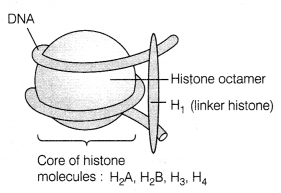
The length of DNA is 2,2 mm in a human dipoid cell. This
large-sized DNA is accommodated in the smaller area through packaging or
compaction. This is achieved by folding and attachment of DNA with basic
proteins (e.g. histones in eukaryotes.)
Question 27.
Menstrual cycle begins from the first day of last period and
end on the first day of next. Normally the length of menstrual cycle day vary
from person to person, but the average length of a cycle can be anywhere between
24 to 35 days.
(i) Can you indentify the days when the following processes
are most likely to occur.
(a) Fertilisation of gametes
(b)
Implantation
(ii) What changes will occur in the endometrium between days 5
and 25 of the menstrual cycle? Relate the hormone associated with these changes.
Also mention what would be the most likely consequence if the progesterone is
lacking in an adult woman?
Or
Pollen a mass of microspore in a seed plant
appear usually as a fine dust. These are produced by the anthers of the stamens
is flowers. Pollen consist of one or more vegetative cells and a reproductive
cells.
They have high generating power thus, can remain active for longer
time.
(i) How the pollen grain can remain active for longer time?
(ii) The
outer layer of pollen grain is discontinuous. Explain why.
(iii) How are
pollen banks useful?
Answer:
(i)(a) Fertilisation of gametes occur between
days 14 to 20.
(b) Implantation occurs between days 19 to 25.
(ii) The endometrium or innermost uterine lining starts to buildup from day 5. It becomes thicker for the purpose of occurrence of possible fertilisation and get supplied with more blood vessels.
A surge in oestrogen levels correspond with the initial buildup of the endometrium, followed by a surge in the levels of progesterone to maintain and thicken the endometrium further.
If progesterone is lacking in an adult women, the thickness of the uterine
lining may not develop sufficiently enough for an embryo to safely develop. It
may also cause abnormal uterine bleeding in women who are not pregnant.
Or
(i) Pollen grains can remain active or alive for longer duration due to
the presence of sporopollenin on the outer surface.
This layer protect the
pollen grains from harsh and unfavourable environment.
No enzyme that degrade
sporopollenin is so far known. That is the main reason, that the pollen grain
are well-preserved as fossils.
(ii) The outer layer of pollen grains, i.e. exine is discontinuous because the pollen tube germinates by growth of intine through these thin parts of exine called germ pores.
(iii) Pollen banks can be used for storing pollen grains for years and for crop breeding programmes.
Question 28.
Explain the functions of inducer repressor and co-repressor
in an operon.
Answer:
Inducer is a chemical substance, which on coming in
contact with the repressor inactivates it by changing its conformation and forms
a repressor-inducer complex. This complex is unable to bind to operators, thus
allowing the transcription to occur.
Repressor It is a type of protein synthesised by regulator gene. The repressor is meant to block the operator gene, so that the structural gene is unable to form mRNA. The repressor may be present in active or inactive forms.
Co-repressor It is a protein in eukaryotes, which indirectly regulates the expression of genes by binding to the repressor proteins.
Section D
0. Nos. 29 and 30 are case-based questions. Each question has 3 subparts with internal choice in one subpart.
Question 29.
Study the inheritance chart for colour blindness in a couple,
where no history of this disease is present in the female partner.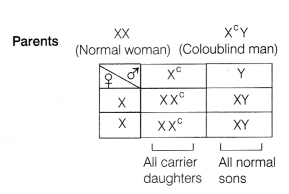
(i) What is the probability of their grand children being
colourblind in case?
(a) Carrier daughter marries a normal man.
(b)
Carrier daughter marries a colourblind man.
(ii) What would happen to
children of all their sons?
Or
(ii) The gene for colour blindness is
present onX-chromosome. How does this affect its inheritance?
(iii) Briefly
explain another genetic disorder showing similar trait.
Answer:
(i) The
probability of their grand children being colourblind when
(a) Carrier
daughter marries a normal man.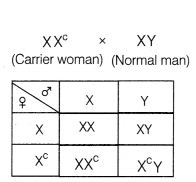
Thus, 50% of their grandsons will be colourblind and 50% of
their grand daughters will be carrier.
(b) Carrier daughter marries a
colourblind man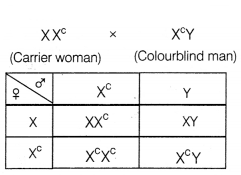
Thus, 50% of their grandson will be colourblind, 50% of their
grand daughters will be colourblind, while rest 50% grand daughters will be
carrier. In both cases, 50% of grandsons will be colourblind. Thus, the
probability (overall progenies) is 0.25%.
(ii) The children of all their sons will be normal provided their wife is not
a carrier or colourblind person.
Or
(ii) The gene for colour blindness is
present on X-chromosome. Thus, it is an X-linked recessive trait. The
inheritance of sex-linked traits occurs from father to daughter or mother to
son. This is known as criss-cross inheritance.
(iii) Haemophilia is another sex-linked recessive disease. It shows transmission from unaffected carrier female to some of the male progeny. In this disease a single protein involved in clotting of blood is affected. Due to which an affected individual can suffer non-stop bleeding in a simple cut also.
Question 30.
The data below shows the function of immune system towards an
antigen X?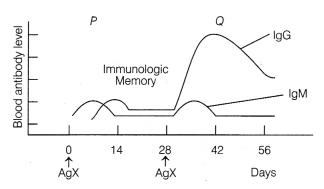
(i) With reference to the above graph, explain the response generated by our
immune system at P?
(ii) Evaluate the efficacy of Q towards antigen X.
(iii) Our immune system helps to protect us against virus and bacteria. Which
cells of the immune system that helps in this function?
Or
(iii) Our
environment contains a huge range of pathogenic microbes and toxic substances
that challenge the host by a very broad selection of pathogenic mechanisms. It
is not surprising therefore, that the immune system uses a complex array of
protective mechanisms to control an usually eliminate these organisms and
toxins. Which general feature of the immune system is responsible for such
targeted action?
Answer:
(i) The P is identified as a primary immune
response. It occurs when an antigen comes in contact with our immune system for
the first time. Our body learns about this antigen, produce antibodies and keeps
memory cells against it. Level of antibodies reaches peak in 7-10 days. Thus, it
is of low intensity.
(ii) Q represents the secondary immune response which develops due to a subsequent encounter with X. At this point, an immunological memory is already present due to memory cells. This results in the generation of a quick and an intense immune response towards antigen X (usually 2-3 days). With each subsequent exposure, the response gets more efficient and individual becomes resistant to the pathogen.
(iii) The immune cells are B-cell and T-cells. B cells generate memory cells
which keeps memory of the first exposure to antigen and helps in generating more
intense response in subsequent infections T-cells fight the antigen.
Or
(iii) The mechanisms of our Immune system rely on detecting structural features
of the pathogen or toxin that mark it as distinct from host cells, such host
pathogen or host-toxin discrimination is essential to permit the host to
eliminate the threat without damaging its own tissues.
Section E
Question 31.
Mathew Meselson and Franklin Stahl perfomed an experiment,
which proved that DNA replicates semiconservatively for that they grow E. coli
in a medium containing 15NH4Cl which result in the
incorporation of 15N isotope in to newly synthesised DNA. They their
transfered the cells in to a medium with nomal 14NH4Cl and
took samples at various definite time intervels as the cells multiplied and
extracted the DNA that remained as double-stranded helices.
The DNA extracted
from the culture at various time intervals are tabulated below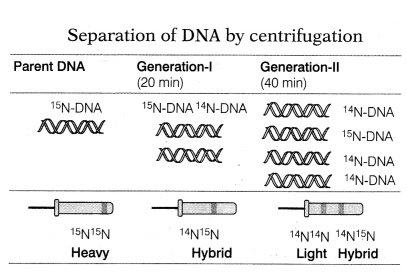
Now, calculate what will be the proportion of light and hybrid densities of DNA
molecule if E. coli is allowed to grow till 4th generation having same time
interval between each generation?
Or
Anuradha made a chart containing
codes for various amino acids. In which column A consist of amino acids whereas
column B consist of there respective codes. But some places in both the columns
are missing. Help her in completing the given chart by filling the correct codes
and amino acids.
| S.No. | Column A (Amino acid) | Column B (Codes) |
| 1. | Proline | CCU, CCC |
| 2. | …A… | UUU,UUC |
| 3. | Valine | …B… |
| 4. | Lysine | …C… |
| 5. | …D… | GAA GAG |
| 6. | Serine | …E… |
Answer:
If coli is allowed to replicate till 4th generation, i.e. 80 min
then it will divide four times, producing four generation.
In the first generation, i.e. after 20 min, all the strands will be hybrid density DNA molecules.
In the second generation, i.e. after 40 min 50% of the strands will be hybrid density molecule and remaining 50% will be light density molecule.
In the third generation, i.e. after 60 min 25% of the strands will be hybrid density molecule and remaining 75% will be light density molecules.
In the fourth generation, i.e. after 80 min 12.5% of the molecule will be hybrid density and 87.5% will be light density DNA molecule.
Therefore, it can be concluded that after 80 min at the end of the 4th generation 12.5% hybrid DNA and 87.5% light density DNA molecule will be produced.
Thus, the proportion of light density to hybrid will be 7 : 1.
Or
The missing amino acid and codes are as follows.
| S.No., | Column A (Aminoacid) | Column B (Codes) |
| 1. | Proline | CCC, CCC |
| 2. | Phenylalanine | UUU, UUC |
| 3. | Valine | GUC, GUA |
| 4. | Lysine | AAA, AAG |
| 5. | Glutamic acid | GAA, GAG |
| 6. | Serine | AGU, AGC |
Question 32.
Biotechnologists created Bt cotton by inserting DNA from a Bt
bacterium into the cotton plant’s DNA.
Following this insertion of modified
Bt DNA into cotton plants, many companies moved the Cry protein tract into high
performance cotton varieties for commercial benefits Bt cotton offers a vastly
improved methods of delivery of Cry proteins to target insects than other
traditional methods increasing the overall yield.
(i) List two advantages of
using Bt cotton in comparison to chemical sprays.
(ii) Illustrate the mode of
action for Bt toxin after its been consumed by a boll worm larvae.
(iii) Does
Bt cotton affects beneficial insects? Discuss.
Or
The graph below depicts
some of the GM crops being cultivated in the US.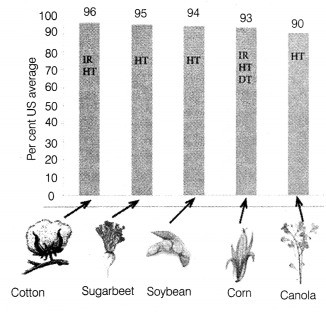
(i) Are you aware of the traits for which genetic modification is carried out in
these crop plants?
(ii) The first stage in making a GM plant requires
transfer of DNA into a plant cell. How is this achieved?
(iii) In India, the
regulation of all activities related to GMOs and products are regulated as per
the rules of the manufactures / use / import/ storage of hazardous
microorganisms, genetically engineered organisms or cells, 1989. These rules are
implemented by Ministry of environment, forests and climate change, Dept. of
Biotechnology, Govt, of India with respect to GMOs what is the agenda behind
establishing such agencies?
Answer:
(i) Advantages of using Bt cotton
are
(a) The Bt protein produced within a plant remain protected from rapid
environmental degradation.
(b) It ensures that all larvae will eat the Cry
protein because it is always present ail over the plant.
(ii) Mechanism of action of Bt toxin after its consumption by an
insect.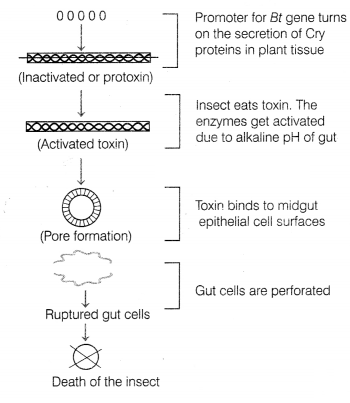
(iii) Studies have shown that cry IAc in Bt cotton is highly selective since it
destroys only certain caterpillar species. Bt cotton has minimal or no effect on
other beneficial insects like bees, beetles, spiders, wasps, etc. However, it
may indirectly lower the general abundance of some beneficial insects which prey
upon caterpillars, since it causes a decline in caterpillars’ numbers.
Or
(i) Most existing genetically modified crops have been created to
(a) develop
resistance against pests, insects which can damage the crops, e.g, Bt gene from
Bacillus thuringinesis has been inserted In crop plants to develop resistance
against insects.
(b) develop herbicide tolerance which enable effective
chemical control of weeds, e.g canola, soybean, etc.
(c) develop disease
resistance towards common pathogens like bacteria, virus, fungi, etc. e.g. Bt
corn.
(ii) To transfer the gene of interest in piant cell,
(a) Coat the surface
of small metal particles with selected DNA fragments and bombard these particles
into plant cells. This is called as biolistic gun.
(b) Virus / bacteria
mediated DNA transfer. The bacteria most commonly used in Agrobacterium
tumefaciens. The gene of interest is transferred to the bacterium, which is then
made to infect the piant. This bacterium then delivers the DNA (Ti-plasmid
mediated) to the host plant which then grows and express the trait for which it
was modified.
(iii) The government agencies reviews the information related with GM crops. For example, its nature, stability of transgene, effects on non-target organisms, potential for allergic reactions, etc. If agencies are satisfied that proposed GM crop does not pose any threat to other living organisms and environment, it can be approved for cultivation.
Question 33.
Trace the development of embryo from a fertilised ovum till
its implantation in the uterus.
Or
Although, seeds in general are the
products of fertilisation, but a few flowering plants have evolved special
mechanisms to produce seeds. Discuss these mechanisms in brief.
Answer:
The development of embryo from fertilised egg and its subsequent development is
called embryogenesis.
It includes following events
(i) Cleavage : The
mitotic division begins when the zygote moves through the isthmus of the oviduct
towards the uterus, forming 2, 4, 8,16 daughter cells called blastomeres. During
cleavage, the young embryo moves down the Fallopian tube towards the uterus.
(ii) Formation of morula : The embryo with 8-16 blastomeres is called morula. The morula continues to divide and transforms into blastocyst, while moving further into the uterus.
(iii) Blastulation : The blastomeres in the blastocyst get arranged into an outer layer called trophoblast and the inner group of cells get attached to trophoblast and is called the inner cell mass. The trophoblast layer then gets attached to the endometrium and the inner cell mass differentiates into the embryo. After attachment, the uterine cells divide rapidly and cover the blastocyst.
(iv) Implantation : As a result, the blastocyst becomes embedded in the endometrium of the uterus. This called implantation and it leads to pregnancy.
(v) Gastrulation : The process of embryo development during which primary
germinal layers are formed followed by organogenesis.
Or
The special
methods for seed production are discussed
below
(i) Apomixis : It is a
form of asexual reproduction that mimics sexual reproduction and produces seeds
without fertilisation. Thus, there is no gametic fusion or zygote formation. For
example, Asteraceae and grasses.
Apomictic seeds are viable. These are produced from segments of fruit (mango stem), male gametic content of pollen (Cyperus) and other vegetative parts.
In some species, the diploid egg cell is formed without reductional division and develops into embryo without fertilisation. It is an asexual reproduction in the absence of pollinators and takes place in extreme environments.
Apomixis is extensively used in hybrid seed industry since production of hybrid seeds is costly, if hybrids are made into apomicts, there is no segregation of characters in the hybrid progeny. Then, the farmers need not to purchase hybrid seeds year after year and can use apomictic seeds to raise new crops every year.
(ii) Polyembryony : It is the occurrence of more than one embryo in a seed. In gymnosperms, polyembryony can occur due to cleavage of growing embryo. It occurs in some species of Citrus (orange and lemon), onion, groundnut and mango varieties.
(iii) Parthenocarpy : The production and development of seedless fruit is called parthenocarpy. It is of two types, i.e. vegetative and stimulative. In vegetative parthenocarpy, the seedless fruits can develop even without the stimulus of pollination, e.g. pear.
In stimulative parthenocarpy, the stimulus of pollination is required without actual process of fertilisation, e.g. grapes.